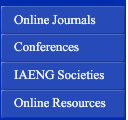

 |
 |
 |
 |
|
Engineering Letters
ISSN: 1816-0948 (online version); 1816-093X (print version) Subject Category: Computer science and engineering Published by: International Association of Engineers
Contents: Volume 13, Issue 1 (Online version available: 4 May 2006)
ADVERTISEMENT: One-stop government in the enlarged Europe: launch of the European OneStopGov project Adamantios Koumpis, Director of the Research Programmes Division of ALTEC S.A. and Editorial Board Member of Engineering Letters. Engineering Letters, 13:1, 2006 [Full Text]
One-stop government in the enlarged Europe: launch of the European OneStopGov project OneStopGov addresses the area of one-stop government by means of developing and validating a life-event oriented framework and platform, with the aim to enable "24 hour, single point access to public services that are integrated around citizens needs". Currently however, online one-stop government projects in Europe do not care about citizens needs and do not provide integrated services from different back-offices. The OneStopGov project aims to specify, develop and evaluate a life-event oriented, integrated, interoperable platform for online one-stop government. This platform will be accompanied by a coherent framework for realising and exploiting online one-stop government at all levels. The guiding vision, challenge, innovation and unique selling proposition for the OneStopGov platform involve: the inherent support of life-events; the active, citizen-centric approach; and the definition and use of generic models (e.g. generic workflows, generic reference models). The OneStopGov platform will be based on a number of scientific and technological innovations:
The OneStopGov platform and framework will be deployed in three new Member States (Slovenia, Hungary and Poland) and one Accession country (Romania). The platform will be used for modelling, implementing and deploying 16 life-events. The consortium includes two organisations responsible for eGovernment at national level (Slovenian ministry of Public Administration and the company owned by the Hungarian Prime Minister's Office), one at regional level (the region that includes Bucharest), and one at local level (Polish municipality) thus ensuring maximum visibility and take-up of the project's results. Some information on the background and the need for the projectThe notion of one-stop government, initially developed in UK in early nineties within the context of 'traditional government services', proved to be equally or even more relevant within the context of eGovernment. The idea is to provide integrated public services to the citizens and businesses at 'one place' and in 'one go' thus eliminating all the unnecessary waiting times and confusion about 'who is responsible for what'. The interest in one-stop, life-event portals was so big, that the 2004 published worldwide study of Accenture "eGovernment Leadership: High Performance, Maximum Value" revealed that " Most governments offer some central point for accessing services..." Public authorities at all levels also rushed to follow the trend. The portal industry rapidly reacted to the new market needs by introducing new governmental portal families for public authorities of all levels and sizes, which claimed to provide true one-stop capabilities. Despite all this interest and funding however, the results have not been satisfactory. Recent studies suggest that the reasons are mainly two:
Consequently, citizens (even politicians) tend to refrain from using these portals or even ignore their existence. Innovations in the OneStopGov approachIn order to clarify the project's innovative approach and contrast it to other approaches with similar objectives we present a classification of relevant approaches. The approach followed by each category in providing information, handling eServices and back-office integration is also summarised below in tabular form.
To achieve our objectives we plan to advance the current state-of-the-art in the areas of life-events and active life-event portals and through them the area of online one-stop government. Life-events have not yet been adequately studied in a rigorous, scientific manner. We plan to advance the state-of-the-art by systematically studying the structure of life-events, identifying a suitable modelling language and specifying a small set of relevant life-event reference models. Active life-events have only recently emerged and therefore research in the area is still at an infant stage. In OneStopGov we plan to investigate the architecture of active life-event portals and supporting online one-stop government technical infrastructure, which involves research in intelligent, adaptive, knowledge-based interfaces, generic workflows, ontologies for life-events, and semantic Web and Grid technologies.? Finally, comprehensive online one-stop government frameworks have not been proposed. In OneStopGov we will provide a framework that will address organisational issues (e.g. organisational and semantic interoperability, employees' resistance, business process re-engineering and improvement etc), all-inclusive roadmaps, guidelines, social studies etc. We should note here that different consortium partners are already conducting research in the areas of online one-stop government, life-event portals, generic workflows, Web technologies for eGovernment, etc. A list of consortium partners' publications that are relevant to the OneStopGov project can be found in Appendix A. The OneStopGov proposal aims to bring these research teams to work together in order to achieve the overall project objectives. You can receive more information from the project Website: http://www.onestopgov-project.org
Adamantios Koumpis is Director of the Research Programmes Division of ALTEC S.A. and and Editorial Board Member of Engineering Letters, and responsible for the Dissemination and Exploitation activities of the OneStopGov project. You can contact him at: akou@altec.gr.
Coming Special Issues of Engineering Letters Engineering Letters welcomes author submission of papers concerning any branch of the engineering and the computer science and their applications in business, industry and other subjects. The subjects covered by the journal include artificial intelligence, bioinformatics, computational statistics, database, data mining, financial engineering, hardware systems, imaging engineering, industrial engineering, internet computing, networking, operations research, scientific computing, software engineering, and their applications. All submitted papers are to be peer-reviewed for ensuring their qualities.
|
Engineering Letters
Join IAENG Now!
|

|
International Association of Engineers © Copyright International Association of Engineers |


